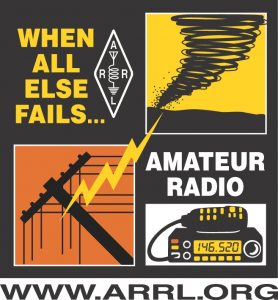Weather Spotter Network
Ham Radio Club Members can be severe weather spotters, especially youth members! Even if you have not been trained, you can read the information here and on connected weather pages to learn. If you are a licensed ham and can reach the repeater network, call it in by radio. Or, anyone can type weather data directly into the form on the next page. If you attended our training session or are experienced, run Net Control for a while. Take turns with others so everyone gets the experience.
- Stay indoors – report what you can from your home or current location.
- Lightning – never go outside during a lightning storm.
- Downed electrical wires – if your house has lost power assume there are downed wires that are live and could electrocute you.
- Debris – in windy conditions debris could be flying and can cause injury or damage.
- Flooding – never drive, walk, or enter a flooded area.
What to report
- Scanner monitoring – listen to your local public safety frequencies and report any damage or issues heard.
- Snowfall – as described on Winter Criteria page
- Thundersnow – lightning or thunder during snow
- Flooding – any flooding, especially if over 6″-12″ deep and what it is impacting
- Ice accretion – anything over ¼″ – see Winter Criteria page for how to measure it
Damage
- Any sort of damage from wind, like tree branches breaking, fences blown over, etc.
- During large snow events any roof collapses or other weight of snow damage.
Reporting by Radio
- Tune into the W1STR weather net, if active, on the W1STR repeater network.
- Listen first to see if there is an active net or anyone is using the frequency.
- If a net is active call W1STR <your call> or announce your call to get net control’s attention.
- Net control will answer your call and ask for your information. Remember to say your call sign when finished.
- During major storm events stay off the radio other than to inform net control you are on the net and to report weather information.
- For minor storm events normal conversations can continue. Remember to leave gaps between stations to allow others to break in.
- If needed, use the call “break” to get net control’s attention.
Starting a Net
- If a weather net is not currently active, start the net and become net control.
- Announce your intentions of starting a weather net and becoming net control.
- The club call sign WX1CLA can be used for the net control of the weather net. Periodically also give your own call sign.
Running a Net
- If you need to leave the radio, ask if someone can take over for you as net control.
- If you are on a net, and the net control disappears, step up and become net control.
- Periodically do a roll call of stations, especially when traffic is light to keep people engaged and to know who is still active on your net.
- When conditions improve or the storm is over close the net.
Net control tips
- Have a pad of paper and pen to write down check ins, reports, notes, and other information.
- During general conversations, feel free to jump in and ask if anyone has any reports.
- To pass along information:
- When asked by an appropriate station relay the reports over the radio
- Submit the information into the report summary forms.
- If you are unsure about something do not be afraid to ask others on the net or one of the club leaders for help or assistance.
